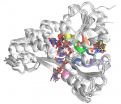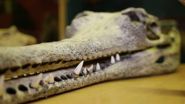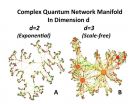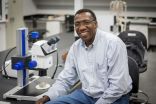(Press-News.org) James Cook University scientists have played a role in a discovery that may alter the known history of humankind.
JCU's Professor Paul Dirks and Dr Eric Roberts were part of a team that explored the Rising Star Cave system in South Africa.
A chamber deep in the caves was found to contain multiple specimens of what is being called Homo naledi - an extinct, previously unknown species related to modern homosapiens.
Testing at JCU and the University of Johannesburg shows sediments in the chamber did not come from external sources, ruling out the possibility of flash flooding or other catastrophic events leading to the fossils getting into the chamber.
Professor Dirks said the remains were found at the end of a narrow passage in a section where sunlight never reaches, known to scientists as the 'dark zone'. A newly-released paper co-authored by the pair attempts to throw light on the discovery.
"Nothing is certain at this early stage, but a lot of the evidence points to the chamber being a potential deliberate body disposal site," said Professor Dirks.
Professor Dirks said the features of Homo naledi are similar to other early hominids, combining a human-like face, feet and hands, but with a short, ape-like torso and a very small brain.
"It is a mixture of primitive features and evolved features. It shows there were different species of hominids alive at different times that combined all sorts of different features. Nature was experimenting."
The scientists said only a small part of the cave has been excavated and there are hundreds, if not thousands, more bones in the cache, making it a unique and valuable site. The site is also unusual for its lack of any other large vertebrate bones except those of Homo naledi.
"Discoveries are often made of single bones or single jaws and teeth. But so far the team has removed 1500 bones from the Rising Star system from almost every part of the skeleton. It's a goldmine, it will play a key role in telling the story of human ancestry," said Dr Roberts.
Access to the final chamber is gained by dropping into a narrow 20cm-wide gap in the rock.
"You crawl several hundred metres into the cave system through some very narrow squeezes," said Dr Roberts. "Then that final drop into the chamber is very intimidating. It requires a technical rock climb and you hyperventilate a bit going down."
Scientists believe there has never been an alternative, easier route into the chamber.
The cave system is now under the care of the University of Witwatersrand.
Study of the site will likely continue for decades.
INFORMATION:
Researchers at EMBL's European Bioinformatics Institute (EMBL-EBI) have developed a new method for studying the targets and effects of cancer drugs using data from discovery mass spectrometry (MS) experiments. The study is published in Nature Communications.
Understanding the biological signaling pathways that regulate metabolism and gene expression is challenging, because so many things are happening at once. But this understanding is crucial for knowing how a drug will affect healthy and cancer cells. Protein kinases play a pivotal role in these pathways by turning ...
NS3 is an enzyme specific to the hepatitis C virus. If developed, a drug capable of recognizing and selectively attacking it could fight the disease without side effects for the body. However, to be able to develop one we need to know more about the behavior of this important protein in the virus replication process. Some SISSA scientists have provided a detailed and comprehensive view of the behavior of NS3. The study has been published in the journal Nucleic Acids Research.
According to the WHO, a good 140 million people are affected by hepatitis C (3/4 million new cases ...
While sexual contact is not the most efficient means of hepatitis C (HCV) transmission, there have been several reports of outbreaks of sexually transmitted HCV in HIV-positive men who have sex with men (MSM). HCV infections are more likely to become persistent and to lead to progressive liver disease in people who are HIV-infected, even if they are receiving HIV treatment. Factors underlying these infections in HIV-positive MSM are only partially understood.
Researchers at NYU's Center for Drug Use and HIV Research (CDUHR) at the College of Nursing (NYUCN) have conducted ...
Future computers will require a magnetic material which can be manipulated ultra-rapidly by breaking the strong magnetic coupling. A study has been published in Nature Communications today in which Swedish and German scientists demonstrate that even the strongest magnetic coupling may be broken within picoseconds (10-12 s). This will open up an exciting new area of research.
The element gadolinium is named after the Uppsala chemist Johan Gadolin who discovered the first rare-earth metal yttrium in the late 1700s. Gadolinium is in the same class of elements and it has ...
Dublin, Thursday September 10th, 2015 - Scientists from Trinity College Dublin have discovered that one gene mutation in a single species can trigger dramatic changes in whole biological communities; changes can be as great as those caused by the extinction of a top predator.
By using bacteria to replicate ecological systems in the lab, they found that mutations of a single gene that alter how one bacterial species interacts with others had huge structural impacts across their multi-species microbial communities. These 'social mutants' varied in their ability to produce ...
Mathematicians investigating one of science's great questions -- how to unite the physics of the very big with that of the very small -- have discovered that when the understanding of complex networks such as the brain or the Internet is applied to geometry the results match up with quantum behavior.
The findings, published today (Thursday) in Scientific Reports, by researchers from Queen Mary University of London and Karlsruhe Institute of Technology, could explain one of the great problems in modern physics.
Currently ideas of gravity, developed by Einstein and Newton, ...
This news release is available in Japanese.
The Earth's atmosphere contains oxygen because plants continuously produce it through photosynthesis. This abundant supply of oxygen allows life forms like animals to flourish. Therefore, oxygen had been thought to be an essential biomarker for life on extrasolar planets. But now, a research assistant professor Norio Narita of the Astrobiology Center of National Institutes of Natural Sciences (NINS), which was founded in April 2015, and an associate professor Shigeyuki Masaoka, of the Institute of Molecular Science of NINS, ...
DENVER (Sept. 10, 2015) - An international team of scientists, including one from the University of Colorado Denver and another from the University of Colorado Anschutz Medical Campus in Aurora, announced the discovery Thursday of a new species of hominin, a small creature with a tiny brain that opens the door to a new way of thinking about our ancient ancestors.
The discovery of 15 individuals, consisting of 1,550 bones, represents the largest fossil hominin find on the African continent.
"We found adults and children in the cave who are members of genus Homo but ...
A new study conducted in collaboration with Facebook using anonymised data from the social networking site shows a correlation between people's social and financial status, and the levels of internationalism in their friendship networks - with those from higher social classes around the world having fewer friends outside of their own country.
Despite the fact that, arguably, people from higher social classes should be better positioned to travel and meet people from different countries, researchers found that, when it comes to friendship networks, people from those ...
ATLANTA -September 10, 2015- A new study finds breast cancer incidence and death rates are increasing in several low and middle income countries, even as death rates have declined in most high income countries, despite increasing or stable incidence rates. The findings come from a new report examining global patterns and trends in breast cancer using the most up-to-date cancer registry-based data available. It appears early online in Cancer Epidemiology Biomarkers and Prevention.
Breast cancer is the most commonly diagnosed cancer among all women worldwide overall and ...




